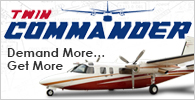In the ecosystem of Twin Commander Factory Authorized Service Centers, all provide maintenance and sell parts, many perform major upgrades, and some even operate airplanes on charter, sightseeing, and other special contracts. No other center does it all quite like the GAM Group.
The Melbourne, Australia-based company currently operates 21 Twin Commanders. The fleet includes 17 Shrikes, two 680s and two 690s. Those 21 airplanes fly every day in a variety of roles including freight, passenger charter, sightseeing, aerial photography, and more.
The majority of the company’s flying in the past was centered on transporting bank checks. As technology has changed, GAM has had to change to keep up with it. Now the primary cargo is what CEO Carl Jepsen calls pathology. In other words, blood and other samples for testing. This and other freight accounts for about 75 percent of the flight operations, with 25 percent split between various passenger-based missions. One reason Jepsen loves the Twin Commanders is because the team can quickly and easily adapt the airplane to the mission. “We can go from passengers to freight literally within minutes and adapt from one mission to the next,” he said. “We’ve got it down pat.”
While it’s not known which specific airframes in the worldwide Twin Commander universe have the highest number of flight hours, it’s a safe bet GAM is operating at least a few in the top five. Their highest-time airframe has an astounding 40,000 hours on the clock, and the total continues to increase.
To keep their fleet in top shape GAM has an in-house program to upgrade each airframe on condition. They hang new engines, overhaul the undercarriage, repaint, and replace interiors. “When the aircraft starts to look a certain way or there’s a bit of fatigue, we’ll do it,” Jepsen said. Along with maintenance and time-limited items such as engines, they base the upgrade decision on visual standards that keep passengers happy because, as Jepsen says, “Boxes don’t care if paint is not so shiny.”

In addition to performing all their own in-house maintenance, GAM also provides service to about three dozen outside clients. In fact, maintenance is at the center of the company’s history. In 1983 aviation maintenance technician Steve Knott opened a small facility in what is now a historic hangar at Essendon, and named the business General Aviation Maintenance. Four years later he bought his first Shrike Commander, and quickly added more. Over the years a few that were deemed uneconomical to repair or had spar issues were retired, but the original Commander fleet amassed by Knott is mostly intact.
Today GAM is certified under Australia’s CAR 30 and Part 145 repair station standards, and can help customers with parts, engines, airframe, avionics, electrical, paint, and most other needs. “There’s not a lot we don’t do,” Jepsen said.

Like most businesses, the coronavirus has impacted GAM’s operations. Australia has taken a state-by-state approach to restrictions, which initially made compliance a challenge. But because of GAM’s important freight operations the company was deemed essential and never stopped flying. They’ve been adding pilots, including some who left for greener pastures and have come back to flying an airplane they know and love. “This is the first time in a long time that we have more work than airplanes, and that’s a good problem to have,” Jepsen said.
Jepsen said GAM has looked at operating other airplanes, but concluded that Commanders are versatile and adaptable from one operation to the next and nothing else can match it. “There’s nothing we’re not doing with the Commander. Nothing can compete.”




